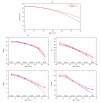A nonlinear model with latent process for cognitive evolution using multivariate longitudinal data
- PMID: 17156275
- PMCID: PMC1930148
- DOI: 10.1111/j.1541-0420.2006.00573.x
A nonlinear model with latent process for cognitive evolution using multivariate longitudinal data
Abstract
Cognition is not directly measurable. It is assessed using psychometric tests, which can be viewed as quantitative measures of cognition with error. The aim of this article is to propose a model to describe the evolution in continuous time of unobserved cognition in the elderly and assess the impact of covariates directly on it. The latent cognitive process is defined using a linear mixed model including a Brownian motion and time-dependent covariates. The observed psychometric tests are considered as the results of parameterized nonlinear transformations of the latent cognitive process at discrete occasions. Estimation of the parameters contained both in the transformations and in the linear mixed model is achieved by maximizing the observed likelihood and graphical methods are performed to assess the goodness of fit of the model. The method is applied to data from PAQUID, a French prospective cohort study of ageing.
Figures




References
-
- Amieva H, Jacqmin-Gadda H, Orgogozo J, LeCarret N, Helmer C, Letenneur L, Barberger-Gateau P, Fabrigoule C, Dartigues J. The 9 year cognitive decline before dementia of the Alzheimer type: a prospective population-based study. Brain. 2005;128:1093–101. - PubMed
-
- Arminger G, Muthén B. A Bayesian approach to nonlinear latent variable models using the Gibbs sampler and the Metropolis-Hastings algorithm. Psychometrika. 1998;63:271–300.
-
- Dunson D. Bayesian latent variable models for clustered mixed outcomes. Journal of the Royal Statistical Society, Series B. 2000;62:355–66.
-
- Dunson D. Dynamic latent trait models for multidimensional longitudinal data. Journal of the American Statistical Association. 2003;98:555–63.
-
- Fabrigoule C, Rouch L, Taberly A, Letenneur L, Commenges D, Mazaux JM, Orgogozo JM, Dartigues JF. Cognitive process in preclinical phase of dementia. Brain. 1998;121:135–141. - PubMed

